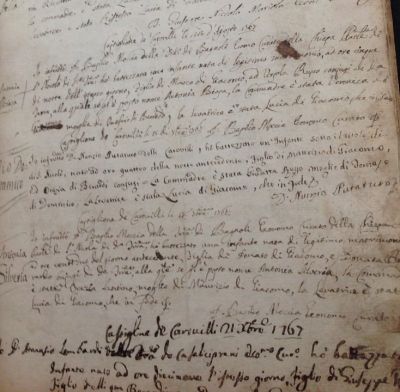After you have exhausted all the available online sources for Italian records, both civil and ecclesiastical, your next step can be to write directly to Italy to request records. This month we are going to cover some tips on how to prepare your correspondence and review sources that will help you write a letter in Italian.
Basic Tips and Managing Your Expectations
Before you start writing your letter, make sure that you have enough information available for the record holder to find the right record: the more details, the better. In a village, there may be numerous individuals with the same name and about the same age as your ancestor. For example, I once requested a birth record for my grandfather, Antonio Torella, who was born “about 1884.” I received the record of a different Antonio Torella who was a month older. The lesson I learned from this was to provide details such as his parents’ names and a more accurate birth date – as much information as possible. Consider including the names of a future spouse or children who were from the village as it could help pin point the right family when a common name is being searched.
It is also important to keep in mind that town officials and parish priests are often very busy with their official duties and may not have the time or, with the case of a parish priest, the inclination to do exhaustive research. When you send a request, be very specific about which records you are asking for and be polite. A request that is viewed as demanding may be ignored. Be patient and do not impose a deadline, you need to stay on the record holder’s good side, and you need them more than they need you.
You will also need to write your letter in Italian. There are excellent resources available to help with this. You should also type your letter to make it easier for the Italian record holder to review. I also recommend that you be mindful of the number of records you are requesting – I would say a good rule of thumb is no more than two or three per letter. If you need more, be sure to space your requests by a few months to avoid annoying record holders.
When writing to a parish, let the priest know that you are writing because you have exhausted other avenues, i.e. have already checked the civil records.
If you are sending your letter via postal mail, expect it to take up to two weeks to arrive. Patience throughout this process is needed. As I mentioned earlier, town officials and priests are often very busy and genealogical requests are not one of their top priorities. It may take four to six months to receive a reply, if you receive one at all.
How to Find Addresses
Once you have decided what records you want and have gathered all the details you know, the next step is to find out where to send your request. For civil records, write to the local town official. Visit http://www.comuni-italiani.it/index.html to find an address. You may even find an email address enabling you to send your inquiry electronically. This site also lists the names of the local parishes. Finding the right parish can be a challenge if there are more than one serving the community. The Catholic Church in Italy has an online directory of churches at www.chiesacattolica.it. Other helpful websites are www.parrocchie.it and www.wikipedia.com.
How to Compose a Letter
The Church of Latter Day Saints’ “Family Search Wiki” has created an excellent detailed online source for how to compose a letter and it provides samples of various Italian sentences that will be useful in writing your letter. There is also guidance on how to inquire about the cost for records. www.familysearch.org/wiki/en/Italy_Letter_Writing_Guide.
Another excellent source for guidance on letter writing can be found in Trafford R. Cole’s book, “Italian Genealogical Records: How to Use Italian Civil, Ecclesiastical and Other Records in Family History Research.” Although this book was published in 1995, it is still one of the most comprehensive guides for Italian genealogy. He devotes an entire chapter to letter writing. in boca al lupo!



